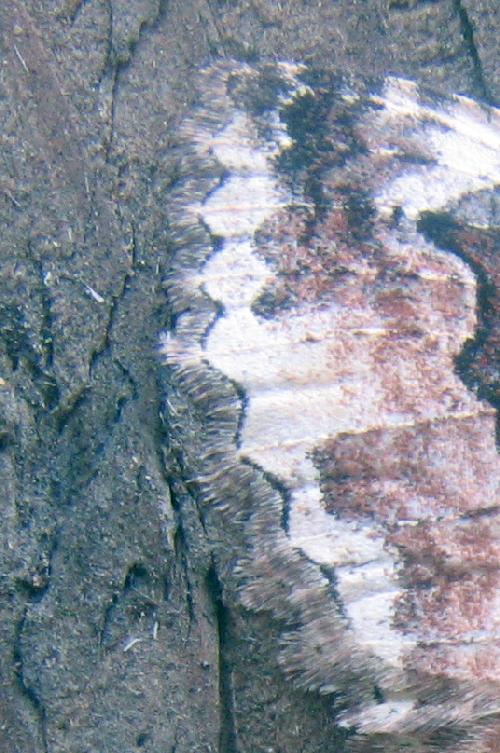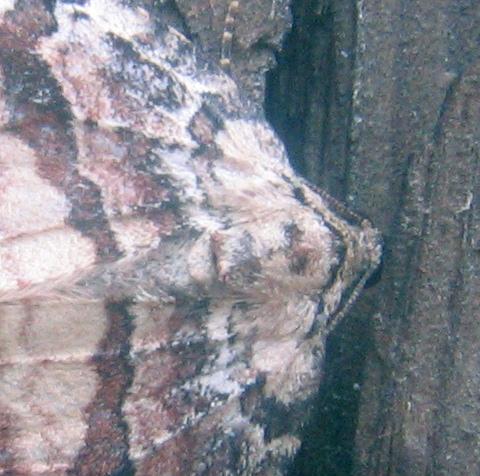Moth found under siding – Carpet Moth
I had to consult with the experts on this one. It is a good example of why a simple insect guide is not much good for identifying moths
So, on the 20th of May, 2007, I was tearing down an old outbuilding[1], and tore off a piece of wood-shake siding to find this underneath:
This was a pretty good-sized moth, as we can see in this next picture (the tip of my index finger is included for scale):
The patterning on its wings looks quite a lot like lichen on a tree, so I suspect that it would normally have hidden on the bark of trees, but this siding was just too secure of a place to hang out for it to pass up. It was very inactive, so I’m not sure if it was just strongly nocturnal, or if it had been hibernating under there and was still dormant from the winter (our “last frost” in this area is generally around the middle of May).
Unfortunately, this is where I got stuck[2]: a lot of moths have evolved this sort of patterning so that they can hide out on tree trunks. I couldn’t even narrow it down to the family with any confidence: it looked to me kind of like the genus Eulithis, which is in the Geometrid family [3]; but it also looks kind of like the Phalaenophana genus, of the Noctuoidea superfamily; and then again, it is not out of the question that it is one of the Pyraloidea superfamily (although those look a bit more tenuous).
About all I had to go on here was the way it held its wings (flat, and spread out into kind of a delta-wing pattern), the feathering and scalloping on the trailing edges of the wings:
and the shape of the head and antennae:
So, it looked like it was going to have to remain “Moth found under siding in late May, family unknown”, unless I could get a pointer from someone more expert than me.
That someone turned out to be Bob Patterson on BugGuide. From the picture I posted there, he thinks it is probably Triphosa affirmata[4]. He says this is:
“one of the “carpet moths” in Geometridae, a group that can be highly variable with respect to color and pattern. You could conceivably encounter several moths of a single species on the same night that seem so different that you would wonder if you were looking at several species.”
So, I was on the right track in thinking it was a geometrid moth, but I should have been looking at the genus Triphosa
——–
[1] It was an odd sort of building – it looked like an old house, with a wood-piling “foundation”, wood-shake siding, standard house-style windows and a door, a wooden floor covered with a layer of concrete about two inches thick, and an upper loft area with a staircase that was this close to being a ladder instead of stairs. Of course, the siding was falling apart, the roof leaked, the “foundation” had disintegrated on the west side to the point that the west wall was collapsing, and the structure had dry-rot so bad that a person could punch a hole in the side with bare hands if so inclined. It was an eyesore, and a hazard, and in the way, so it had to go. I did manage to recover some usable lumber from it, but for the most part it was worthless. After we tore it down, the previous owner of the place told us that it wasn’t actually an old house, it was a “Finnish-style granary”. Which was kind of a relief. Anybody actually living in that, would probably have been better off living in a tent, even when it was new. Especially since there was no sign of any fireplace or chimney, and it gets *cold* around here.
[2] Part of the reason why I waited over a year and a half to post this, is that I thought for sure that I’d eventually be able to sort out what it was on my own. But, the more I looked, the more uncertain I got. So, I submitted it to Bug Guide in hopes that some moth expert would see it, take pity on me, and say, “Oh, that’s clearly a {fill in the blank here}”. And it worked!
[3] Geometrids are what inchworms turn into when they grow up. I really need to find more inchworms to photograph next summer.
[4] This is the first time I’ve been to the site for the Moth Photographers Group, and it looks like it is a really good resource for trying to identify moths. The problems with moth identification in general are, first, they tend to be a lot more nondescript than butterflies (probably because they fly at night, so colors aren’t going to be that useful). Second, what colors they do have, tend to be camouflage colors, because they all try to hide out during the day. And, since they are all trying to blend in with the same backgrounds, they end up with similar colors and patterns. And third, there are probably ten species of moth for every one species of butterfly, so a guide to moths would be this massive thing the size of an unabridged dictionary. Which is why there are several decent field guides to butterflies, but no really good guide to moths.
Comments are closed.





I love your writing style. You bring a drama to each discovery. I’m also running off to check out the Moth Photographer’s Group now …